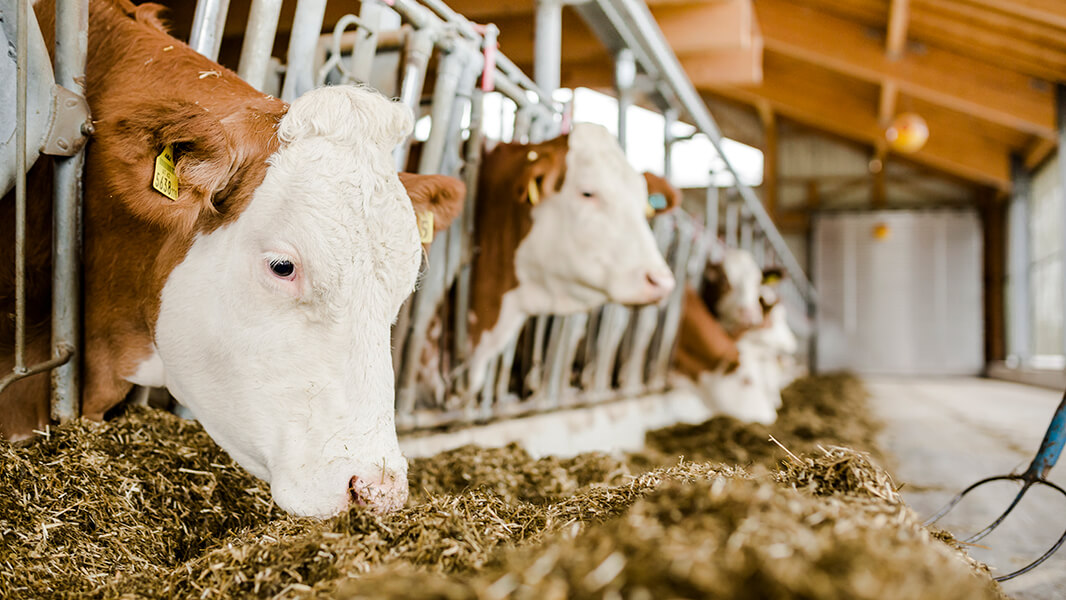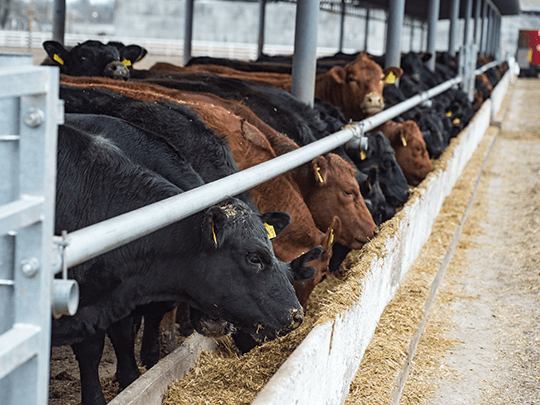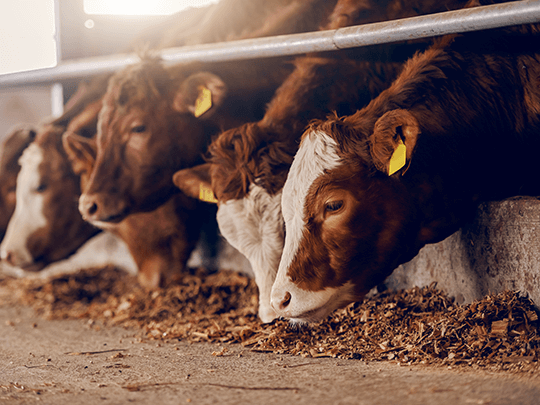
Growth performance in beef cattle and small ruminants
Successful cattle producers know: Feed efficiency and growth performance in beef cattle are the key to profitability. Enhanced feed conversion results from improved nutrient utilization and metabolic efficiency which, simply stated, generates more meat from each pound of feed. Improved feed efficiency provides opportunity for improved resource utilization, reduced environmental impact, and considerable savings of feed costs.
Did you know?
Between 11 and 27 pounds of feed are required to produce 2.2 pounds of meat in beef cattle and lambs. The feed conversion rate (FCR) increases with the age of animal due to a reduction of the metabolized nutrient production and absorption. Feed conversion rate is strongly linked to genetics and the capacity for muscle deposition. For young bulls FCR is between 4 and 8. For aged cows, the FCR is between 7 to 20.

High daily gains depend on a sufficient supply of fat and starch
In order to meet the requirements of high performance through optimal feed efficiency, the feeding strategies in beef production concentrate primarily on covering the energy requirement with carbohydrate-rich rations. To ensure that sufficient energy and glucose are available to support high growth rates, fermentable carbohydrates comprise a large portion of diets for finishing cattle.
This means that in addition to high-quality roughage, up to approximately 30% starch can be found in the rations. Part of the starch is fermented relatively quickly in the rumen by amylolytic bacteria into volatile fatty acids, which are the main source of metabolic energy. A second part is hydrolyzed by the enzyme amylase in the small intestine to energy providing glucose.
An issue with feeding high percentages of concentrate is that the roughage intake decreases, which can reduce chewing activity and consequently saliva production. Decreases in saliva production result in lower buffering capacity in the rumen during starch fermentation which can lead to a significant drop of ruminal pH and changes in the microbial populations. Maintaining a stable rumen environment is the critical to support high levels of concentrate feed intake and maintain feed efficiency.
Did you know?
From an energy standpoint, it is more efficient to digest starch enzymatically directly in the small intestine than to break it down into volatile fatty acids in the rumen and then undergo the process of glucose formation in the liver.

Maintain rumen functions for high performance
In order to maintain supply of glucose and energy to the small intestine, feedstuffs such as corn or sorghum are often used which contain a high proportion of "bypass starch". This form of starch is broken down relatively slowly and incompletely in the rumen, allowing larger amounts to enter the small intestine. Though, the efficiency of bypass starch use is determined by both glucose uptake and the extent of starch hydrolysis in the small intestine.
The combined effects of stimulated feed intake and better utilization of digestible bypass starch and fat in the small intestine minimize energy loss. By reducing carbohydrate degradation in the rumen and increasing the buffer effect of salivary flow, the risk of drastic changes in the ruminal pH and subsequent microbial population shifts can be reduced. Consistency of rumen environment is necessary for optimal feed conversion and average daily gain in finishing cattle.
Do you want to find out more about other Challenges & Solutions?
Actifor™ Power - for beef production

In vivo and in vitro studies have shown that Actifor™ Power solutions:
- can help optimize feed intake, which supports lactate production and impact normal salivation, which helps balance feed-related deviations of the normal ruminal ph
- support feed intake, thereby leading to optimal nutrient availability for growth performance and carcass yield in fattening cattle
- while increasing intake - may support digestion and utilization of digestible bypass starch and fat in the small intestine, thus potentially helping minimize energy losses
Our phytogenic Actifor™ Power solutions help maintain pH in the rumen when feeding carbohydrate-rich rations, while improving energy efficiency in ruminants. The sophisticated formula of essential oils, natural spices and saponins stimulates feed intake, which contributes to fattening performance and average daily gains of beef cattle. Actifor™ Power solutions have a positive effect on the physiology of ruminants, which research trials have shown help to improve performance and carcass yield.
Nature that works
Actifor™ Power solutions have been shown to improve feed intake, average daily gain and feed conversion ratio.
| Parameter | Actifor™ Power Effects |
|---|---|
| Dry matter intake (D.M.I) | +0.66 lb/day |
| Average daily gain (ADG) | +0.15 lb/day |
| Feed conversion ratio (FCR) | -0.06 |
Actifor™ Power solutions have been shown to increase feed intake and consequently, carcass weight increased significantly in several trials run in research facilities and commercial farms.
Some products are only approved for use in certain geographies, end uses, and/or at certain usage levels. It is the customer's responsibility to determine, for a particular geography, that (i) the product, its use and usage levels; (ii) the customer's product and its use; and (iii) any claims made about the customer's product, all comply with applicable laws and regulations. *Any references to “natural/naturally” are as defined by www.aafco.org. Any references to “feed additive(s)” are as per the laws and regulations in the United States. For product registration information, please refer to the product data sheets.
Get in contact

Megan Koppen
RTM Poultry, Sales Group North America
Phone:
+1 (630) 731-0250
e-mail:
Megan_Koppen@cargill.com